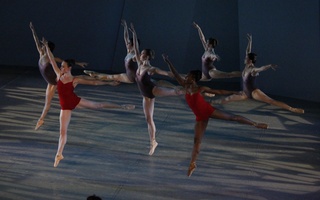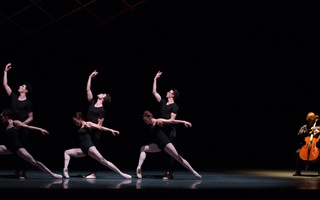The Harvard Radcliffe Modern Dance Company’s new show “40,” proves that at their middle age, the dance troupe is as graceful as it’s ever been and promises many more decades of inspired modern dance. A tribute to the organization’s 40th anniversary, the performance bridged the past and the present with 11 pieces that each took inspiration from their past productions but featured completely new choreography by both current students and returning alumni. The show incorporated both popular songs by the likes of Frank Ocean and Kanye West and poetry and music composed by students. Every piece was stunning in its own right, and the contrast among the dances contributed to the show’s overall success.
“40” began with “Pandemonium”, a piece choreographed by Jazmine K. Phillips-Acie ’18, which featured Kanye West’s “Wolves” and Lorde’s “Everybody Wants to Rule the World.” It was an intense piece to start the show, as it depicted a power struggle amongst the dancers, who fought for a coveted scepter. The only flaw in “Pandemonium” was the often too literal interpretation of the lyrics; cut the music, rather than the choreographer’s vision, seemed to be the author of the piece. However, in every other way, Phillips-Acie showcased brilliant craftsmanship. The drastic transition from Kanye to Lorde and the kaleidoscopic changing light schemes contributed to the sense of perfectly balanced chaos. Together, the lights, music, and choreography created a dramatic uneasiness, as if the dancers’ world were just barely on the verge of pandemonium, suspended momentarily in this beautiful instant of competition. The following dance, “In Transit” by Gabe S. Martinez ’18, offered a stark contrast, with the cool tones in both costumes and lighting lifting the tension the previous performance had created. Throughout the show, this pattern repeated itself—stress followed by tranquility, heartbreak followed by joy.
Another highlight of the first act was “With Intent” by Joel W. Bateman ’17, featuring Frank Ocean’s “Solo.” The eight dancers in Bateman’s piece wore simple Adidas track pants and white T-shirts, which drew more attention to the dancers’ body language. Teeming with emotion, the word was a beautiful portrait of the pain of a breakup. The end was a solo that continued after the lights turned off, which reinforced the feeling of loneliness.
A less successful piece of the night was “Reconfigured” by Julia Sweeney ’19, which was uncomfortable in an interesting but somewhat overwrought fashion. The piece began with a solo dancer who performed frequent, uncontrollable convulsions of his limbs. As more dancers entered the stage, they fell prey to similar struggles, such as beating their heads against their palms and various twitches. While the piece consisted of three distinct scenes, the dancers ultimately reverted to their bad habits. Had it been shorter, “Reconfigured” would have had more provocative power. However, the piece was so long that eventually it pushed past the uncomfortable and simply became disturbing.
Sofie R. Seymour ’16 began the second act with her gorgeous reflections on mankind’s relationship with nature, “Enough Space.” The soothing earth tones of both lighting and costumes, along with the magnificent wooden headpiece that crowned Harvard Extension School student La’Toya Princess Jackson, set the scene in a forest. The dance ended with the other five dancers worshipping Jackson as Mother Nature in a cultish manner.
Two pieces in the second act incorporated other student artists: “Tempo” relied on the live performances of Laila M. Smith ’17, Carlos A. Snaider ’17, and Alex S. Graff ’17, who played original music by Tree A. Palmedo ’16, a former Crimson Arts executive, while “Excerpts” featured a poem by Kyra A. Atekwana ’14 and Yasmeen E. Audi ’15. The musicians in “Tempo,” who sat around the theater, came on and off stage and even sat in the audience, further emphasizing the theme of connecting past and present. However, the movements of the musicians at times also distracted slightly from the piece.
Ultimately, “40” contributed to a variety of ongoing conversations within the arts about topics such as nature, breakups, mental illness, and power. As a dance company, HRMDC entered these discussions in a unique way, using the human body as a voice for opinions. Moreover, it successfully brought together past artists to reinforce the idea that inspiration is cyclical and that creative energy can constantly be borrowed and repurposed.
Read more in Arts
“Jazz 100” a Fitting Tribute to the Legends

















